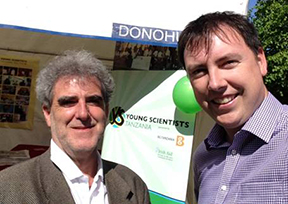Interviews

Names: Joe Clowry and Brendan Doggett
TCD Qualifications: Joe: B.A., M.A., & H.Dip. in Education (1978)
Brendan: B.A. & Ph.D. in Physics (2005)
Titles: Co-Founders of Young Scientists Tanzania
About: Joe Clowry and Brendan Doggett are the two leading Irish people involved in Young Scientists Tanzania. Founded by Joe Clowry, this unique project in Africa provides a platform for young Tanzanians to demonstrate their innovation and showcase their scientific talents.
What inspired you to start up Young Scientists Tanzania?
Joe:
I had been promoting the concept of Science for Development in Ireland since 2006. My role as Education Officer gave me the opportunity to expose East African researchers to the Irish Young Scientist model while they were on training programmes in Ireland. They were amazed at the quality of research being undertaken by secondary school students and realised the impact that the Young Scientist concept could have in developing a science culture in their country. I began working on transferring the Irish model to Tanzania in 2009 and eventually launched the Young Scientists Tanzania project in November 2011.
How did you and Brendan start working together on this project?
Brendan:
I was living in Tanzania with my family in 2011 and lecturing in the University of Dar es Salaam. In my spare time I was working in local secondary schools developing instructional materials with their science teachers. I met Joe at a dinner hosted by the Irish Embassy for the local Irish business community. It was clear that we both shared a passion for science so I was easily convinced to support the project in any way possible. I’m happy to say we still have the same enthusiasm for the project after all these years!
How did your Trinity education pave the way for your career?
Brendan:
I graduated with a B.A. (Mod.) in Natural Science and a Ph.D. in Physics in 2005. Trinity and in particular the School of Physics was such a diverse and intercultural environment which encouraged me to look at science from a global perspective. I’m in contact with my colleagues from Trinity and fortunately some still volunteer their time to participate as judges in the Tanzanian exhibition.
Since its launch in 2011, how has the Young Scientists Exhibition Tanzania evolved?
Joe:
When the project launched in 2011, only four schools from around Dar es Salaam were involved. In 2015, schools from all 30 regions in Tanzania participated at the annual exhibition. This meant that some students travelled for two days over dirt roads to attend the exhibition. To become the first Tanzanian national science project is a remarkable achievement and shows the amazing support for the project in the country.
What has been your proudest achievement so far with this project?
Brendan:
This year will be as on the 21 July we plan to pilot our first regional exhibition in Mtwara. It will give more students the opportunity to showcase their academic potential at a regional level. This expansion will bring the exhibition to students in remote areas.
What is the greatest lesson you have learnt from your involvement with Young Scientists Exhibition Tanzania over the last six years?
Joe:
When Tanzanian students are given an opportunity to engage with scientific research, they are as innovative, articulate, inspired and motivated as any student in the developed world. It was heartening to see that when students were presented with the opportunity, they did not waste it. A strong science culture is rapidly developing in the schools that are involved in the Young Scientists Tanzania exhibition.
Tell us about the positive impacts this exhibition is having on Tanzanian students?
Brendan:
The success of Young Scientists Tanzania lies in the mentoring of students and teachers in the scientific method across the country. We promote the project as an exhibition rather than a competition. Young Scientists Tanzania is also unique as it awards scholarships to two of the most economically disadvantaged students from our outreach work. The scholarships are awarded to those who demonstrate high academic potential. This is a transformational opportunity for some of the poorest students in the world. We also provide two university scholarships to the overall winners.
What are the next steps for the Young Scientists Tanzania project?
Joe:
The next steps are to expand the project to all schools across Tanzania. The pilot plan for Mtwara means we will be able to reach up to 4,000 schools over the next few years. The top projects in each region will then present in the annual national exhibition. The next important phase is the challenge of transferring the model to other countries. I have been to Kenya several times, to give advice on how they can embed the Young Scientists model in their country.
What advice would you give to alumni who want to initiate or get involved in projects such as this?
Brendan:
My advice to all alumni is to maintain, develop and expand their networks. The world has become such a small place and technology has brought us even closer together. It is important to use this to your advantage and keep your network informed. Often, a small project you initiated may be the vital missing part of a much larger project, however if nobody knows what you’re doing, the opportunity may pass you by.

